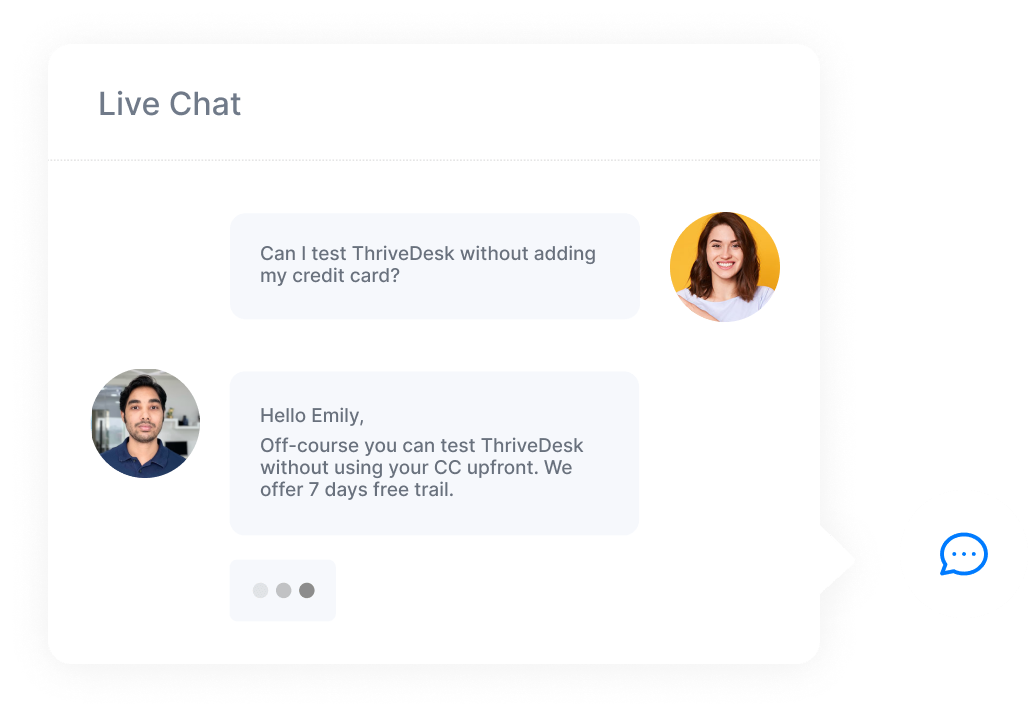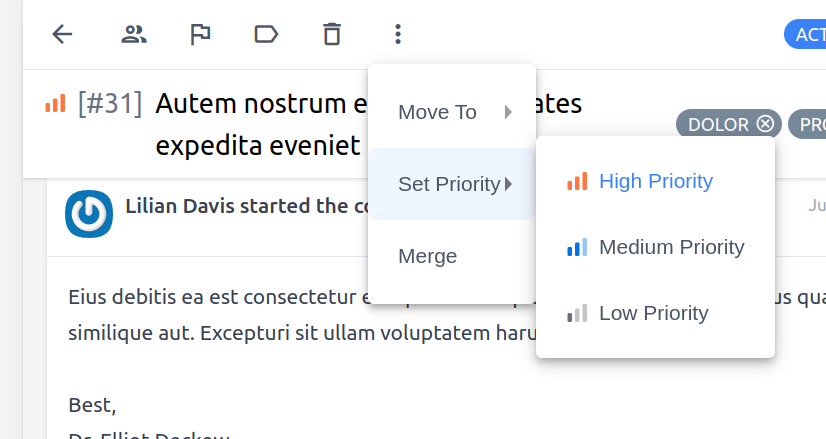When it comes to customer service, advice is abundant, yet everyone keeps the really helpful tips to themselves. Call it “keeping a competitive edge” or downright greed, but we at ThriveDesk see things a bit differently.
Knowledge gained is not just a tool, it’s a gift. And like any gift, its true value is realized when shared freely. Over our decade-long experience in facilitating exemplary customer service experiences, we’ve come to understand the power of collective wisdom.
The following are 15 tips for customer service that we’ve learned through our own experiences providing customer service day in and day out. We believe any customer service team worth their salt should know these.
Qu'est-ce que le service à la clientèle ?
Customer service is the support provided by businesses to customers before, during, and after a purchase. It aims to address inquiries, resolve issues, and ensure satisfaction, fostering long-term relationships.
The goal of customer service is to ensure customer satisfaction by addressing inquiries, resolving issues, and delivering a positive experience, ultimately fostering long-term relationships and loyalty.
15 Actionable Tips for Customer Service

Tip 1: Equip Your Team with the Right Tools
Having the right customer service tools and platforms is foundational to delivering exceptional support. The wrong tools will severely hinder your team’s ability to provide a great experience.
Action Steps:
- Invest in a dedicated customer service platform built specifically for support, not just ad-hoc email management. Look for features like built-in customer profiles, collision detection, and collaboration tools.
- Ensure the platform provides context about your customers, their account history, past interactions, and any key details. This allows agents to have more personalized, informed conversations.
- Implement internal knowledge bases where agents can access product documentation, process guides, and a repository of resolved issues. This reduces repetitive questioning.
- Choose tools that enable clear communication channels with customers through multiple mediums (email, chat en direct, phone, etc.) based on their preferences.
- Look for platforms that foster teamwork with features like integrated team inboxes, collision alerts when teammates are viewing the same request, internal notes, and the ability to easily transfer or escalate conversations.
The right tools provide a comprehensive view of the customer and their needs while streamlining the agent experience for efficient communication and collaboration. Antiquated emails and spreadsheets won’t cut it – investing in modern, purpose-built customer service software is a must for delivering truly excellent support at scale.
Tip 2: Communicate Effectively
How you communicate with customers can make or break the experience. Using clear, conversational language is crucial for ensuring they understand you and feel heard.
Action Steps:
- Avoid jargon, technical terms, and internal acronyms that customers won’t comprehend. Stick to plain language.
- Write as you would speak in a casual conversation. Use contractions and simple sentence structures.
- Be friendly and personable, not overly formal or stiff. This helps build rapport.
- Pay attention to tone. Never come across as condescending, passive-aggressive or rushed.
- Ask clarifying questions to ensure you understand the customer’s situation fully before responding.
- Use positive language that focuses on solutions, not negative phrasing about what can’t be done.
- For complex topics, break down your explanation into short, simple points. Don’t overload with information.
- Read your messages out loud before sending to catch unclear wording or unintentionally harsh tones.
Effective communication prevents misunderstandings, frustration and makes the customer feel like they’re being listened to by a knowledgeable human, not an uncaring robot. By simply adjusting how you communicate, you’ll elevate the entire customer experience.

Best Customer Service
Looking to elevate your customer service game? ThriveDesk is your ultimate solution! With its intuitive features and seamless interface, it streamlines customer interactions and boosts satisfaction. Try ThriveDesk today!
Tip 3: Listen and Address Concerns Properly
Customers reach out because they need help or have an issue to resolve. Actively listening to understand their situation and addressing concerns properly is critical.
Action Steps:
- Practice active listening by giving the customer your full attention, not multi-tasking or thinking about your response while they are still speaking.
- Allow the customer to fully explain their perspective and issue without interrupting them.
- Ask clarifying questions to ensure you completely understand the situation and their expectations.
- Show empathy by acknowledging their feelings, even if the issue isn’t your fault. Use phrases like “I understand this is frustrating” or “I can see why you’re upset.”
- Don’t discount, dismiss or argue against their complaints or viewpoint, even if you disagree. Validate their perspective and apologies where needed.
- Make the customer feel heard by summarizing and repeating back key points.
- Prioritize first-contact resolution – take the time to fully investigate and resolve the core issue on the first interaction if possible.
- If the issue is complex, set expectations by providing a timeline and keep the customer informed on progress.
When customers feel truly listened to and that their concerns are being properly addressed, it builds trust and rapport. Avoid the common mistake of rushing through interactions just to clear your inbox. Slow down and give them your full attention.
Tip 4: Streamline with Processes and Self-Service
Having efficient processes and robust self-service options allows your team to maintain high standards while keeping response times low during high volumes.
Action Steps:
- Build a library of saved reply templates for common questions and scenarios. Provide clear guidance on when they should be used.
- Leverage a base de connaissances or help center with FAQs, articles, tutorials, and videos for self-service customer support.
- Make the knowledge base easy to navigate and search. Include screenshots, gifs, or screen recordings where helpful.
- Use strategic automation like email workflows to automatically categorize, prioritize, and route conversations based on keywords or attributes.
- Set up VIP customer workflows to ensure priority treatment for top accounts.
- Create workflows for common activities like refund requests to streamline the process with reminders and approval steps.
- Document your support processes and policies to maintain consistency across the team.
- Schedule regular knowledgebase grooming to prune outdated content and identify gaps.
While tempting to just treat the support inbox as a high-priority to-do list, having thoughtful processes and equipping customers for self-service prevents tickets from endlessly piling up. It allows your team to handle higher volumes efficiently without sacrificing quality.
Tip 5: Adopt a Data-Driven Approach
Relying solely on gut feelings rather than analyzing support data and metrics leads to uninformed decision making. Take a data-driven approach instead.
Action Steps:
- Track and analyze key support metrics like volume, response times, resolution times, one-touch rates, and customer satisfaction ratings.
- Use reporting to identify response/resolution hotspots – which issues are taking the most time or generating the most inquiries?
- Drill down into the details behind the numbers – how much time is really being spent on each type of issue? What are the bottlenecks?
- Aggregate feedback from satisfaction surveys and identify the drivers of positive and negative experiences.
- Collect and analyze feedback submissions, including any recurring complaints or praise.
- Share reports and surface key takeaways in team meetings to drive improvements.
- Don’t disregard data that contradicts your personal theories. Suspend assumptions.
- Use data to objectively evaluate processes, knowledge base content, and existing workflows.
- Make data-informed decisions about staffing needs, training areas, product improvements, and other strategic initiatives.
While it takes discipline, a data-driven culture eliminates guesswork and subjective opinions. You’ll gain invaluable insights that can shape top-priority action items for your team and company.
Tip 6: Surprise and Delight Customers
Going above and beyond with thoughtful gestures and acts of exceptional service can surprise and delight customers in memorable ways.
Action Steps:
- Look for opportunities to add personal touches like handwritten thank-you notes, especially for new customers or major milestones.
- Empower and encourage your team to deliver “frugal wows” – thoughtful acts of service that don’t necessarily involve monetary compensation.
- For loyal customers, consider small gifted brand merchandise or shout-outs on your company’s social media channels.
- During conversations, uncover customer interests, milestones, or context that could allow tailoring of your approach.
- If there was a difficult issue, follow up with a personal email to reiterate your team’s commitment to their success.
- For enterprise or long-term customers, have a team lead or executive periodically check-in and express appreciation.
- Analyze CSAT and other feedback to identify wowed customers and see what your team did right to replicate it.
- Share examples of great service recoveries or gestures in team meetings to motivate everyone.
While products are increasingly commoditized, exceptional service is not. Surprising customers with gestures that make them feel valued creates memorable experiences and builds loyalty. Empower your team to deliver these delightful moments.
Tip 7: Unified Approach
Consistency is key to building trust with your customers. Here’s how to ensure a unified approach across your support channels:
Action Steps:
- Establish a common set of terms and messaging for all customer-facing interactions. This ensures clarity and avoids confusion for both customers and staff.
- Equip your team with clear, concise scripts to address common objections or concerns. This empowers them to handle situations confidently and efficiently.
- Create detailed outlines for handling different scenarios. This ensures consistent workflows and reduces the risk of missed steps or errors.
A unified approach fosters a seamless customer experience. Customers won’t feel like they’re getting different answers depending on who they talk to or which channel they use. By speaking with one voice, you build trust and confidence in your brand.
Tip 8: Foster a Company-Wide Support Mentality
Customer service shouldn’t be siloed to just one team. Fostering a company-wide mentality where everyone is involved leads to better understanding of the customer experience.
Action Steps:
- Have everyone in the company, including leadership, take turns handling some customer interactions or shadowing agents.
- Make CSAT scores, feedback, and support metrics visible company-wide through reports and dashboards.
- Involve different teams like product, engineering, and marketing in the triage and discussion of key customer issues.
- Create open feedback loops where support can easily escalate pain points or requested enhancements.
- Celebrate wins and exceptional service moments with the whole company, not just the support team.
- Build a cross-functional knowledge base that all teams contribute to and utilize.
- Do periodic call reviews across the company to discuss great and not-so-great customer interactions.
- Share customer stories and case studies in team meetings and all-hands updates.
When the entire organization has a stake in customer service, collaboration increases, product improvements are customer-driven, and there is more empathy across the board. It avoids a disconnect between the company and the customer experience.
Tip 9: Exceptional Support Team
Your customer service team is the frontline of your customer experience. Empowering them with the right skills and fostering a passion for service is crucial for creating a winning strategy.
Action Steps:
- Look beyond technical qualifications. Seek out individuals who are empathetic, patient, and genuinely enjoy helping others. During the interview process, assess their problem-solving skills and ability to communicate clearly.
- Provide ongoing training to equip your team with the knowledge and tools they need to excel. This includes product expertise, service protocols, and de-escalation techniques for handling difficult situations. Additionally, consider incorporating soft skills training to strengthen communication, active listening, and emotional intelligence.
- Micromanagement stifles initiative. Trust your team members and give them the autonomy to resolve issues efficiently. Establish clear guidelines and performance metrics, but empower them to make decisions and take ownership of customer interactions. Recognize and reward outstanding service to keep your team motivated and engaged.
Building an exceptional support team takes dedication and investment. By hiring the right people, providing ongoing development, and empowering them to deliver, you’ll create a team that consistently exceeds customer expectations and fosters enduring loyalty.
Tip 10: Close Conversations Properly
Ensuring conversations are properly closed and the customer is fully satisfied prevents issues from being left unresolved or recurring.
Action Steps:
- Don’t abruptly end conversations after addressing the main inquiry. Confirm if there are any other questions or concerns.
- Use phrases like “Is there anything else I can help with today?” or “Please let me know if you need any other assistance.”
- If multiple issues were discussed, summarize the resolution for each before closing the conversation.
- For complex topics, ask the customer to summarize back their understanding to verify you were both on the same page.
- Provide any necessary next steps, whether that’s additional resources, escalation details, or a timeline for upcoming actions.
- Make sure the customer provides clear confirmation that their needs were fully met before closing out the conversation.
- Follow up persistent issues by setting reminders to circle back if the resolution was not effective.
- Monitor for quick re-opened conversations which can indicate a lack of resolution on the first interaction.
- Analyze reasons for conversations being re-opened and identify training opportunities.
Taking the extra minute to properly close out shows you care about completely resolving the customer’s needs, not just clearing your queue. It’s a small effort that prevents bigger headaches down the road.
Tip 11: Close Conversations Properly
The ending of a customer service interaction is just as important as the beginning. Here’s how to ensure you leave a positive and lasting impression:
Action Steps:
- Briefly recap the solution you’ve provided and confirm the customer’s understanding.
- Ask a direct question to gauge their satisfaction. For example, “Is there anything else I can help you with today?” or “On a scale of 1 to 10, how satisfied are you with the resolution?”
- Don’t rush the conversation. Listen attentively for any unspoken concerns or hesitations before ending the interaction.
- If relevant, provide additional resources or knowledge base articles that might be helpful.
- Express sincere appreciation for their time and patience.
By following these steps, you ensure the customer feels their issue has been addressed and their satisfaction is valued. A positive closing encounter strengthens your relationship and fosters trust in your brand.
Tip 12: Speak the Customer’s Language
Customers appreciate clear, concise communication in a language they understand. Here’s how to tailor your approach to resonate with your audience:
Action Steps:
- Adopt a friendly, approachable demeanor. Avoid overly technical jargon or formal language that might create a barrier.
- Pay close attention to the customer’s concerns and the language they use. This helps you understand their perspective and tailor your response accordingly.
- Subtly mirror the customer’s tone and vocabulary to build rapport. This creates a sense of connection and fosters a more positive interaction.
- If technical terms are necessary, explain them in clear, layman’s terms. Use analogies or relatable examples to ensure understanding.
- Don’t assume the customer’s level of technical knowledge. Always err on the side of clear and concise communication.
By speaking the customer’s language, you bridge the communication gap, build trust, and ensure a more productive and satisfying interaction.
Tip 13: Give Credence to Complaints
Every customer interaction, even complaints, presents a valuable opportunity. Here’s how to approach complaints constructively and turn them into positive experiences:
Action Steps:
- Make every customer feel heard. Respond promptly to all complaints, regardless of severity, and show genuine concern for their experience.
- Let the customer know you understand their frustration. Use phrases like “I apologize for the inconvenience” or “It sounds like you’ve been frustrated, and I can see why.”
- Shift the conversation from dwelling on the problem to finding a solution. Work collaboratively with the customer to reach a mutually agreeable outcome.
- View complaints as opportunities to identify areas for improvement. Analyze common complaint themes to pinpoint systemic issues and implement preventative measures.
- Regularly share customer feedback, both positive and negative, with your team. This fosters a data-driven approach to service improvement and empowers everyone to contribute to solutions.
By giving credence to complaints, you demonstrate that you value customer feedback and are committed to continuous improvement. This approach can transform negative experiences into positive outcomes and build stronger customer loyalty.
Tip 14: Avoid Rushing Service
While efficiency is important, un service à la clientèle exceptionnel prioritizes quality interactions over speed. Here’s how to ensure thorough and helpful service without unnecessary delays:
Action Steps:
- Before jumping to solutions, take the time to actively listen to the customer’s concerns. Ask clarifying questions to fully understand the issue and avoid misunderstandings.
- Don’t rush the information gathering process. Ensure you have all the necessary details to diagnose the problem accurately and provide the most effective solution.
- Clearly explain the solution, including the reasoning behind it. This empowers the customer to understand the fix and fosters trust in your expertise.
- Whenever possible, strive to resolve issues on the initial contact. This minimizes frustration for the customer and demonstrates your team’s competence.
- If a complex issue requires further investigation or escalation, be upfront and transparent with the customer. Set realistic expectations for timelines and keep them informed throughout the process.
By prioritizing quality over speed, you ensure customers receive a comprehensive and effective resolution. This approach builds trust, reduces the need for repeat contacts, and ultimately leads to higher customer satisfaction.
Tip 15: Whole-Company Approach
Exceptional customer service isn’t just a responsibility for the designated support team. Here’s how to cultivate a company-wide culture that prioritizes customer experience at every touchpoint:
Action Steps:
- Foster collaboration across departments! Integrate customer journey mapping into training programs for all employees – from marketing and sales to product development and billing. This fosters a shared understanding of the customer experience from all angles.
- Make customer centricity a core value. Encourage all employees to gather customer feedback, both positive and negative, during their interactions. Implement systems for sharing these stories internally – success stories can motivate teams, while negative experiences can highlight areas for improvement.
- Integrate customer feedback into decision-making processes. Consider how new products, policies, or marketing campaigns might impact the customer experience. By prioritizing customer needs across all departments, you create a more seamless and positive experience for everyone.
By adopting a whole-company approach, you ensure that exceptional customer service is woven into the fabric of your organization. When everyone feels responsible for creating a positive customer experience, the results are a more loyal and satisfied customer base.

Prioritizes Customer Quiries
Revolutionize your customer service approach with ThriveDesk, the ultimate solution for prioritizing queries and exceeding expectations. Streamline your support process, boost efficiency, and delight your customers with seamless resolution. Try ThriveDesk today!
Use these tips well
The cat is out of the bag. Now you know what we know. Go forth and use these tips to improve your customer service for your own business. Fair warning: Even if you know what to do now, you’ll find that implementing the strategies and ideas discussed comes with its own set of problems, but that’s a discussion for another day.
These practical tips for customer service can transform your customer interactions from mundane to memorable. Building a customer-centric culture empowers your team to consistently exceed expectations and foster enduring customer loyalty. Remember, it’s the little things – the personalized touches, the streamlined processes, and the genuine care – that collectively create a remarkable customer experience. Start making a difference today, one interaction at a time.





